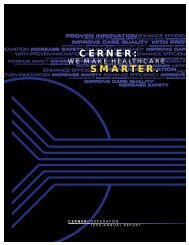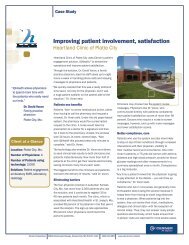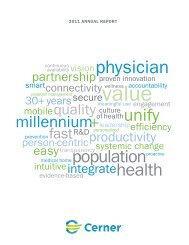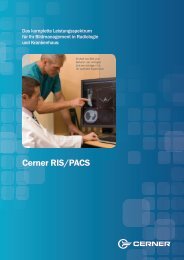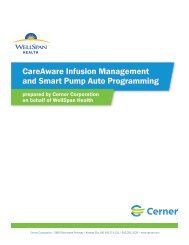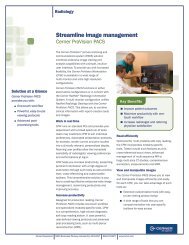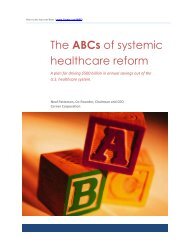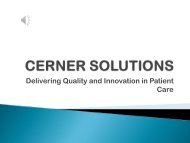The ABCs of systemic healthcare reform - Cerner Corporation
The ABCs of systemic healthcare reform - Cerner Corporation
The ABCs of systemic healthcare reform - Cerner Corporation
- No tags were found...
Create successful ePaper yourself
Turn your PDF publications into a flip-book with our unique Google optimized e-Paper software.
Key provisions <strong>of</strong> the ARRA designate an investment <strong>of</strong> approximately $35 billion 2 to advance the adoption <strong>of</strong> HIT. <strong>The</strong> investment<br />
is predominantly directed toward Medicare and Medicaid to provide incentive payments for hospitals and physicians to adopt<br />
qualified electronic health record (EHR) technology. It is estimated that approximately half <strong>of</strong> the incentive dollars will go to<br />
hospitals and half to eligible pr<strong>of</strong>essionals (primarily physician practices).<br />
To qualify for incentive payments, <strong>healthcare</strong> providers, physician practices and hospitals must meet eligibility requirements and<br />
demonstrate “meaningful use” <strong>of</strong> a certified electronic health record system. <strong>The</strong> legislation provides flexibility for the Secretary <strong>of</strong><br />
the Department <strong>of</strong> Health and Human Services (HHS) to further define meaningful use <strong>of</strong> an EHR, but it initially has been defined<br />
to include the use <strong>of</strong> e-prescribing, the reporting <strong>of</strong> clinical quality measures and the use <strong>of</strong> EHR technology to improve quality<br />
<strong>of</strong> care through care coordination. Additionally, the legislation clarifies that a qualifying EHR system must have the capacity to<br />
capture demographic information about the patient, record a medical history, provide clinical decision support, allow for physician<br />
order entry, facilitate quality reporting and be interoperable.<br />
Approach Virtually Assures a Digitized U.S. Health System by Mid-Decade<br />
Hospitals and eligible pr<strong>of</strong>essionals can qualify for incentive payments beginning in 2011. Eligible pr<strong>of</strong>essionals must qualify<br />
by 2012 and hospitals by 2013 to receive the maximum incentive payments over a four-year period. <strong>The</strong> incentive payments<br />
are designed to fund a meaningful portion <strong>of</strong> the upfront investment by hospitals and physician practices. <strong>The</strong>se payments are<br />
estimated at $4 million per hospital and $44,000 per eligible pr<strong>of</strong>essional. <strong>The</strong> amount <strong>of</strong> the incentive declines if they do not<br />
qualify by 2013. While the “carrot” associated with qualifying for incentives is attractive, the “stick” begins to be used in 2015,<br />
at which time hospitals and eligible pr<strong>of</strong>essionals begin to be penalized with lower Medicare reimbursements if they are not yet<br />
meaningful users <strong>of</strong> a certified EHR system.<br />
We believe few <strong>healthcare</strong> organizations will ignore these powerful incentives. <strong>The</strong>y virtually guarantee that the core U.S. <strong>healthcare</strong><br />
system will be largely digitized by 2014-2016. Analysts currently estimate that less than 10% <strong>of</strong> hospitals and physicians currently<br />
meet the standards necessary to receive incentives and avoid penalties. <strong>The</strong> opportunity is substantial. It is difficult to estimate<br />
the exact timing and amount <strong>of</strong> the impact on our business, but we believe it will be a positive contribution to our core business,<br />
probably beginning in the last half <strong>of</strong> 2009.<br />
More importantly, we also believe this magnitude <strong>of</strong> investment could create the level <strong>of</strong> <strong>systemic</strong> change in the U.S. <strong>healthcare</strong><br />
system needed to address a number <strong>of</strong> serious issues, creating a more efficient, safer and higher quality system for our families,<br />
communities and nation.<br />
Risks <strong>of</strong> Derailing the Impact<br />
It is important to highlight the ways this course <strong>of</strong> action by the U.S. government could get <strong>of</strong>f path. I believe one <strong>of</strong> the largest<br />
ones has been averted already: If the ARRA only funded <strong>healthcare</strong> organizations that had not yet invested in technology, it would<br />
have been a mistake. Instead, it rewards organizations that have been first down this path as early adopters. In reality, these early<br />
adopters are the part <strong>of</strong> the <strong>healthcare</strong> system that will make the biggest difference and be the source <strong>of</strong> the greatest innovations<br />
using their IT investment. <strong>The</strong> HITECH funds under the ARRA will be used to complete their journey.<br />
As mentioned, the HITECH legislation creates the concept <strong>of</strong> “meaningful use.” <strong>The</strong>re could be pressure to dumb down this definition<br />
and make it easy for any <strong>healthcare</strong> organization that has a computer to qualify for the funds. Capitulating to this pressure would<br />
be a mistake. This is too large <strong>of</strong> an investment by the U.S. taxpayer to create a low bar. <strong>The</strong> transformational elements <strong>of</strong> IT<br />
in <strong>healthcare</strong> come from achieving a high bar. <strong>The</strong> high bar is what eliminates avoidable medical errors, unnecessary waste <strong>of</strong><br />
resources, inappropriate variance in medical decisions and outcomes, needless delays in detection and treatment <strong>of</strong> disease, and<br />
costly friction that squanders available funds.<br />
<strong>The</strong>re are other ways this investment could be weakened. But we prefer to address these by describing what is possible if the<br />
investment is made wisely.<br />
2 <strong>The</strong> $35 billion designated for incentives is before estimated penalties for those that do not comply and before expected savings from a more efficient <strong>healthcare</strong><br />
system and higher corporate tax receipts from businesses that will spend less on <strong>healthcare</strong> in a more efficient system. <strong>The</strong> net amount <strong>of</strong> the incentives is<br />
approximately $17 billion.<br />
10



